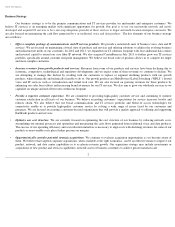Earthlink 2013 Annual Report Download - page 12
Download and view the complete annual report
Please find page 12 of the 2013 Earthlink annual report below. You can navigate through the pages in the report by either clicking on the pages listed below, or by using the keyword search tool below to find specific information within the annual report.
Table of Contents
Communications, Inc. and Time Warner Cable; local and regional ISPs; established online services companies, such as AOL and the Microsoft
Network; free or value
-
priced ISPs, such as United Online, Inc. which provides service under the brands Juno and NetZero; wireless Internet
service providers; content companies and email providers, such as Google and Yahoo!; and satellite and fixed wireless service providers. In
addition, technologies such as 4G, Ethernet or other alternatives to network access, have products or services that compete with ours.
Competitors for our advertising services also include content providers, large web publishers, web search engine and portal companies, Internet
advertising providers, content aggregation companies, social-
networking web sites, and various other companies that facilitate Internet
advertising.
We believe the primary competitive factors in the Internet access industry are price, speed, features, coverage area and quality of
service. While we believe our Internet access services compete favorably based on some of these factors when compared to some Internet access
providers, we are at a competitive disadvantage relative to some or all of these factors with respect to other of our competitors. Current and
potential competitors include many large companies that have substantially greater market presence and greater financial, technical, marketing
and other resources than we have. Our dial-
up Internet access services do not compete favorably with broadband services with respect to speed,
and dial-
up Internet access services no longer have a significant, if any, price advantage over certain broadband services. Most of the largest
providers of broadband services, such as cable and telecommunications companies, control their own networks and offer a wider variety of
services than we offer, including voice, data and video services. Their ability to bundle services and to offer broadband services at prices below
the price that we can profitably offer comparable services puts us at a competitive disadvantage. In addition, our only significant access to offer
broadband services over cable is through our agreement with Time Warner Cable.
Regulatory Environment
Our services are subject to varying degrees of federal, state and local regulation. Communications services are subject to particularly
extensive regulation at both the federal and state levels. Internet access services, which are not communications services, are subject to a lesser
degree of regulation. Federal, state and local regulations governing our services are the subject of ongoing judicial proceedings, rulemakings and
legislative initiatives that could change the manner in which our industry operates and affect our business.
Overview
Through our wholly-
owned subsidiaries, we hold numerous federal and state regulatory licenses to provide communications services.
The Federal Communications Commission (“FCC”)
exercises jurisdiction over communications common carriers to the extent that they provide,
originate or terminate interstate or international communications services or as otherwise required by federal law. The FCC also has authority
over some issues related to local telephone competition. State regulatory commissions, commonly referred to as public utility commissions
(“PUCs”),
generally retain jurisdiction over telecommunications carriers to the extent that they provide, originate or terminate intrastate
communications services. PUCs also have authority to review and approve interconnection agreements between incumbent telephone carriers
and competitive carriers such as us, and to conduct arbitration of disputes arising in the negotiation of such agreements. Local governments may
require us to obtain licenses, permits or franchises to use the public rights-of-
way necessary to install and operate our network. Our operations
are also subject to various consumer, environmental, building, safety, health and other governmental laws and regulations.
The regulatory environment relating to our business continues to evolve. Bills intended to amend the Communications Act of 1934, as
amended by the Telecommunications Act of 1996 (“Communications Act”),
are introduced in Congress from time to time and their effect on us
and the communications industry cannot always be predicted. In late 2013, the House Commerce Committee announced what is expected to be a
multi-
year process to revise the Communications Act. Proposed legislation, if enacted, could have a significant effect on our business,
particularly if the legislation impairs our ability to interconnect with incumbent carrier networks, lease portions of other carriers' networks or
resell their services at reasonable prices, or lease elements of incumbent carrier networks under acceptable rates, terms and conditions. We
cannot predict the outcome of any ongoing legislative initiatives or administrative or judicial proceedings or their potential impact upon the
communications and information technology industries generally or upon us specifically.
Federal Regulation
Our operating subsidiaries that provide telecommunications services subject to FCC authorizations are classified as non-
dominant
telecommunications carriers by the FCC and, as a result, the prices, terms and conditions of our interstate and international communications
services are subject to relatively limited FCC regulation. Like all common carriers, we are subject to the general requirement that our charges,
practices and classifications for communications services must be “just and reasonable,” and that we refrain from engaging in any “
unjust or
unreasonable discrimination” with respect to our charges, practices or classifications.
7
























